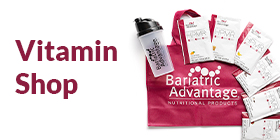Patient Resources
Nutrition After Surgery
- Eating After Weight Loss Surgery for Gastric Bypass Patients
- Examples of Appropriate and Tasty Choices
- Some Examples of "crispy" Foods
- Fruits
- Protein Supplements
- Vitamins
- Meats
- The End of Special Diets
- Chewing
- Dumping
Eating after Weight Loss Surgery for Gastric Bypass Patient
If there was one area that weight loss surgery patients have an excessive amount of concern it would be this – how to eat after surgery. To adequately prepare you for your new lifestyle, we have a pre-operative nutrition class where you will meet with Veronica Patterson, the St Vincent's East Bariatric Coordinator (herself a patient of Alabama Weight Loss Surgery who has lost 230 pounds) and one of the hospital's staff nutritionists who specializes in nutrition after bariatric surgery. Six weeks after your surgery you will have the opportunity to meet again with the nutritionist to ensure you know exactly what to do.
Your goal is to be normal. Most people have dieted their way up to 250, 350, 450 pounds and more. We've measured food, weighed food, portioned food and counted calories to the point of distraction. We've invested more time in food than anything else and the time has come to stop; it is time to be normal.
Initially it will be necessary to take great care with what you eat. However, within several weeks you should be educated enough and familiar enough with the "new you" to put food in it's proper perspective and get on with the business of living. Common sense choices will speed up your weight loss; choose baked chips over fried ones, choose low-fat margarine over butter, etc. These easy substitutions are not only healthy for you but healthy for your family as well. The most successful weight loss surgery patients are those who find the motivation to make major changes in their lives. They are compliant, eat healthy foods, drink plenty of liquids and exercise regularly.
With that said let's proceed to how and what you're going to eat immediately after you are discharged and for the first few weeks after surgery. Consider that you have gone from having the eating habits of a normal adult to the habits of a very young child. How much does a 3-year-old actually eat? A 3-year-old eats about as much as you're going to eat after weight loss surgery. By age 3 children are eating the same foods that mom and dad eat and are no longer eating baby food or specialized foods. If you've ever had a 3-year-old child you know the importance you placed on being sure they had proper nutrition. You must now place that same degree of nutritional importance on yourself. You want to use that limited "stomach" space for healthy, protein rich food. Pre surgery your stomach has an "empty" capacity of 10 ounces but can comfortably expand to hold 40 to 80 ounces at one time. After weight loss surgery your stomach or pouch will have an "empty" capacity of 1 or 2 ounces and, after several weeks or months will comfortably hold anywhere from 3 to 9 ounces. However, you only want to put 1 or 2 ounces at a time in your new stomach for the first few weeks
The Golden Rule of Weight Loss Surgery is "GET YOUR 64'S". You want to get at least 64 ounces of liquids every day and 64 grams of Protein. In the first couple of weeks after surgery you WILL NOT be able to accomplish this so there is no reason to worry unnecessarily. This is a goal that you work at accomplishing. In the beginning as you are adjusting to your new stomach you may find that if you drink something, you're too full to eat anything and vice versa. On some occasions you may find that you have to choose between eating or drinking – in this case choose liquids. During this adjustment phase it will take time to discover what routine works for you. Constantly sipping water or sugar free, non carbonated drinks is the most effective way to get in the much-needed liquids. Remember not to drink for at least 30 minutes to an hour after eating. Drinking immediately after eating overfills the stomach and also washes the food out faster resulting in feeling hungry sooner.
How do you know when you're full? Initially you won't. You won't get that sensation of fullness or satiety. The nerves that provide this feeling work on a "delay" system. When you are eating it takes about 5 minutes for your stomach to tell your brain that it's full. This is why it's so important in this initial period after surgery to eat slowly, chew well and keep your portions tiny. Let experience be your guide. It's a fact that at some point you will accidentally overeat. When this occurs try to remember what you ate, how much you ate, if you chewed thoroughly enough, etc. Storing this information in your mind will help you eliminate the chance of overeating in this manner again. Once you've overeaten your new stomach may feel fragile or tender for several hours or even overnight. When you've irritated your new stomach it's advisable to go back to liquids and nothing heavier than the consistency of applesauce for 12 to 24 hours. This gives your stomach the opportunity to rest and feel better. This shouldn't happen often and following the "applesauce consistency" principal over the next several months whenever you experience irritation should take care of it.
When it comes to eating immediately after surgery, we're going to provide you with a solid foundation but it's up to you to "build the house". We're going to give you several appropriate foods that you can use as building blocks to assemble a menu that is both nutritionally sound and personally satisfying.
Our patients do not go home on a liquid diet. Experience tells us that soft foods are easily tolerated by the new WLS patient. For the first 4 weeks or so you will live by the "applesauce consistency" principal. You want nothing going into that new stomach that is heavier or harder than applesauce. You will want to eat things that are mushy, thin/pasty or runny in consistency.
Some good examples of appropriate and tasty choices are:
- Eggs (whites have more protein than yolks but scrambled eggs are great)
- Grits (prepare a little thinner than you normally would)
- Yogurt (Light or sugar free)
- Applesauce (sugar free)
- Mashed Potatoes (KFC Mashed Potatoes & Gravy work well)
- Pintos and Cheese from Taco Bell (excellent protein source)
- Chef Boyardee Ravioli (mashed to pasty consistency with a fork)
- EMacaroni and Cheese (great protein but watch the calories)
- Broths (Canned or you can use bouillon cubes or granules)
- Northern or White Beans (cooked till super mushy and then mashed)
- All types of soups (chicken noodle soup from Chik-Fil-A is GREAT)
- (put soups with chunky ingredients in the blender first)
- Peanut Butter (Creamy Only)
- Cheese
- Oatmeal
- Cottage Cheese
- Sugar Free Jams & Jellies or No Sugar Added Fruit Spreads
- Surprisingly, there are foods that don't start out as "mushy" but are quite safe and "mushy" once you swallow them. We refer to these as "crispy" foods. A crispy food is defined as one that will disintegrate if you place it in water.
Some examples of "crispy" foods are:
- Saltine crackers
- Melba toast
- Well-toasted bread
- Baked Tortilla Chips
- By combining mushy and crispy foods you will greatly increase your food options during these first few weeks. Baked Tortilla Chips with melted cheese are tasty and "normal". You enjoy eating them and they feel less like a special or restricted diet. As a new post-op 2 to 3 chips with cheese is sufficient to fill you up. One piece of Melba Toast with sugar free jam is a filling breakfast. Instead of picking up that coffee cup, how about picking up a coffee mug filled with steaming chicken broth. You'll be surprised how satisfying it is. You can sip it throughout the day and it's very good for you. 2 open-faced saltines with peanut butter make a great afternoon snack. You will probably find there are foods that you tolerate and like much better than others. You may enjoy eating mashed potatoes and gravy every morning for breakfast and having an egg with melted cheese for dinner. It's important to balance your nutrition with what makes you feel good. This is likely to be an emotional time for you and eating foods you don't care for will only compound this problem. However, balance is the key and making good choices is important. You wouldn't want to eat Melba Toast and Jelly 3 times a day, 7 days a week. Many patients find that experimenting with post op foods prior to surgery makes them better prepared to follow a healthy post op diet.
Fruits
Some fruits can also be part of the soft food diet. Remember that fruits contain natural sugar and in some instances can cause dumping. Particularly fibrous or pulpy fruits such as watermelon and oranges should be avoided during the soft diet phase and should be eaten with great care afterwards. Fruits with skin must be peeled. Remember to chew well. Canned fruits should be packed in light syrup or water. Fruit juices are naturally high in sugar and can result in dumping if consumed in significant quantities.
Some examples of appropriate fruits are:
- Apples (Peeled)
- Pears (Peeled)
- Peaches (Peeled)
- Bananas (experiment with Bananas as they will occasionally cause constipation)
Protein Supplements:
What does protein do? As a nutrient protein performs many functions. Protein is part of every body cell. Your body needs a constant supply of protein to repair body cells as they wear out. During times of growth and healing the body needs protein to make new body tissues. Beyond that, proteins help regulate body processes. For example, as enzymes and hormones, they make various chemical reactions happen. As antibodies, they protect you from disease-carrying bacteria and viruses. Proteins also supply your body with energy if you don't consume enough from carbohydrates and fat (which you try to avoid during weight loss). Otherwise, protein is saved for it's unique function which is to build and repair body tissue. So you can see that it is very important to consume an adequate amount of protein. Prior to WLS most patients consume more than enough protein. After surgery, however, it is often necessary to supplement protein, particularly in the first few weeks or months. Many weight loss surgery patients will tell you that supplementing protein gives them more energy, is helpful in avoiding plateaus and speeds up weight loss by keeping your metabolism up. Protein supplements come in many forms including bars, powdered drink mixes, powdered food additive, pre-mixed bottled drinks, powders and tablets. You will get the maximum benefit of protein if you choose a product containing whey protein isolate. You can check the ingredients of any product to determine protein content. Powdered drink mixes and food additives or pre-mixed bottled drinks are the most beneficial products because they are pre-digested and allow you full benefit of the protein. Bars are an excellent source of protein but you must remember that a bar is absorbed in the same manner that any other food is absorbed therefore, you will not absorb all of the protein. There are dozens of protein supplements on the market available in grocery stores, drug stores, discount stores, health food stores and online. Experimentation is the only way to find one that you enjoy. Some people expect these supplements to be tasty and delicious. This is rarely the case. However, it is generally easy to find one that suits you. You may also simply want to remind yourself that supplementing protein is very good for you and you can spend 5 or 10 minutes of each day drinking something that is only "fair" tasting. With the variety and quantity of products on the market it should never be the case that you have to choose one that is completely distasteful to you. Communicating with other weight loss surgery patients is a good way to get tips and helpful hints about good protein supplements. You may choose to supplement 20, 40 or even 60 grams of protein per day. Bear in mind that your body cannot process more than 30 grams of protein at a time. Therefore, if you use a protein supplement that has 40 grams of protein per serving you are actually wasting 10 grams. Your body will simply slough off what it cannot process. Only body-builders and athletes can process more than 30 grams of protein at a time.
Vitamins:
Most WLS patients start out taking 1 or 2 chewable children's multi-vitamins with iron each day. As time progresses you may change to a small adult tablet with iron. You also want to take 2 types of calcium supplements – Calcium Citrate and Calcium Carbonate. Ultra TUMS (3 tablets) are a good source of Calcium Carbonate. Calcium Citrate can be found in local health food stores and online. You will also take Vitamin B12. Your surgeon may choose to give you B12 shots or you may take a sublingual tablet purchased at local health food stores.
Meat:
During your 3rd or 4th post op week you will probably want to start introducing meat info your diet. A good way to introduce meat into your diet is by eating potted meat, Underwood Chicken Spread or Underwood Deviled Ham Spread and chicken salad. Be sure to check fat content and if making your own, use only light or low-calorie mayonnaise. Experimentation will determine which meats agree with you and what you enjoy. It is advisable to avoid beef in the form of steak, roast, etc. for 6 months. However, processed or ground beef such as you will find in chili, ravioli, spaghetti, etc. seems to be tolerated well. Chicken is an EXCELLENT source of protein and is almost always well tolerated by WLS patients. Fish and pork products are also generally well tolerated. A good rule of thumb where meat is involved is to cut your pieces about the size of a pencil eraser and eat only one piece at a time chewing thoroughly.
The End of Special Diets:
By your 5th post op week you should begin eating the same foods as your family simply in much smaller portions. You've had time to learn what works with your new stomach and what doesn't. You didn't have this surgery only to end up on a life-long diet. Concentrate on protein intake- EAT PROTEIN FIRST AT EACH MEAL - and eating a healthy, well balanced diet. This type of eating is good for both you and your family. You've been given a tool that, if used properly, will enable you to be normal. If you try a new food and it doesn't agree with you, that doesn't mean that you can't ever have that particular food again. You should simply wait a few days or a couple of weeks and then try it again. It will take time to get used to eating such small portions but you will be able to eat enough to be perfectly healthy yet promote maximum weight loss.
Chewing:
Once you have moved beyond the soft diet phase you will begin introducing new foods into your diet. At this point it will be important to chew your food well. You don't want to swallow large lumps of food which can cause painful digestion or even a blockage. Using a blender is unnecessary; you have the best blender in the world right in your mouth – your teeth! As with every other phase of this journey – balance and good sense are the key. You don't want to chew your food to the point of distraction. You don't want dinnertime to become unpleasant because you're spending all your time making sure to chew each bite 100 times. You want to simply be mindful of what you are eating and make sure it is well chewed to a mushy consistency.
Dumping:
What exactly is dumping and will it happen to me? Dumping Syndrome is an event that many gastric bypass patients experience after eating excess fat or sugar. When food leaves your new stomach it empties into a section of the small intestine called the jejunum. The jejunum is simply not designed to handle concentrated calories, particularly excessive fat and refined sugar. The presence of sugar in this portion of the small intestine creates a reaction known as Dumping Syndrome. Your heart can race, you feel sweaty and clammy, have abdominal cramps and maybe even diarrhea and vomiting. These symptoms are followed by an overall feeling of weakness.
It is not dangerous and dumping does not occur in the majority of gastric bypass patients. Many patients who do experience dumping are glad because it is powerful negative reinforcement to avoid sweets.




